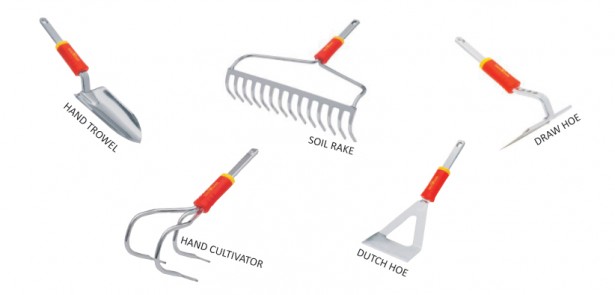The best tools for the job

Now that your garden is dormant until spring, it’s time to assess whether or not your tools are up to the job. ANNE SMITH investigates garden tool essentials, and how to take care of them
Always choose garden tools to match your height and build, and when buying a spade or fork pick up several different types and go through the motions of digging to make certain that the balance and weight suit you and that they are comfortable to use.
Design and materials
Avoid flimsy, poorly made tools however cheap they may be. Badly designed tools made of materials that bend after a little use or with a rough finish or narrow spaces between the tines, where the soil clogs, are worthless. Conventional, good quality steel tools with a smooth finish should be used to obtain the best results with the least physical effort. Stainless steel tools are durable and require only minor maintenance, but they are expensive and sometimes heavy to use. If the weight and balance are suitable they are the best buy because cleaning and oiling is minimal and they will last for many years. Specially deigned tools are available for the elderly and disabled, and some of these may be useful for gardeners who suffer from back trouble or find that conventional tools do not suit them for some other reason.
Maintenance
Always clean garden tools and oil the metal parts as soon as possible after use. Store them in a dry shed or garage. Rusty tools mean harder work and they need replacing more quickly than tools cared for by washing, drying and rubbing over with an oily rag.
Here are some suggestions for a basic set of garden tools…
Spade
Good quality steel or stainless steel with a strong, thin blade for digging.
Garden fork
Good quality steel or stainless steel with four well-spaced, rounded or angled prongs for breaking up the soil. A flat-pronged fork may also be useful for lifting root crops.
Dutch hoe
With its four-inch flat blade, the ideal tool for inter-row cultivation, loosening the soil and uprooting weeds.
Draw hoe
Valuable for taking out seed drills and earthing up crops such as potatoes and celery.
Hand cultivator
With three (or sometimes five) tines, useful for inter-row cultivation to loosen the soil and dislodge weeds.
Soil rake
Essential for seedbed preparation, the rake’s head is also useful as a measuring device for the 12-inch distance between certain crop rows.
Trowel
Ideal with its short handle for planting out seedlings.
Watering can
Try and get one made of strong galvanized steel with a fine brass rose with screw fittings. Strong plastic cans if well balanced when full are as good. Avoid push-on roses because these may become loose and fall off when a full can is tilted suddenly.
Wheelbarrow
A strongly constructed and manoeuvrable barrow either of wood or galvanised steel is best, with a pneumatic or hard rubber tyre. When full it should be well balanced and easily pushed.
All tools pictured are by WOLF Garten and are available from Waterside Garden Centre near the village of Baston on the outskirts of Peterborough. For more information, contact them on 01778 560000 or email
Featured items (from left to right; all prices web exclusive)
HAND TROWEL, £11.99
HAND CULTIVATOR, £13.99
SOIL RAKE, £16.99
DUTCH HOE, £12.99
DRAW HOE, £15.99
Handles for all items are available, prices from £3.99















